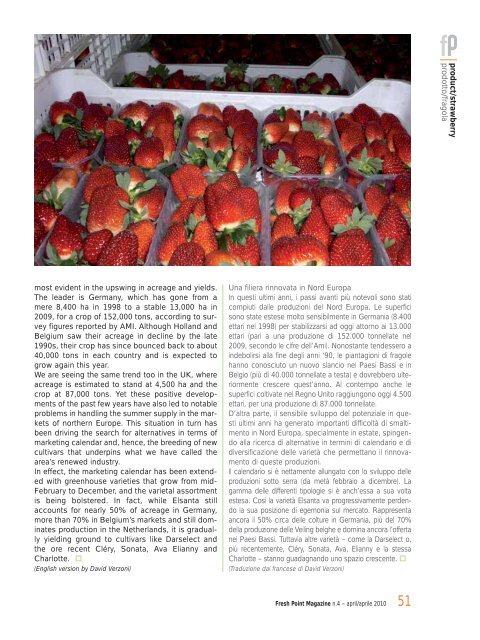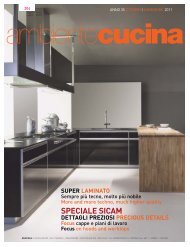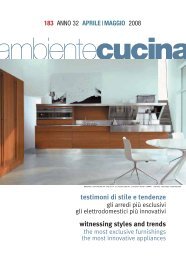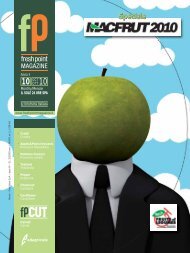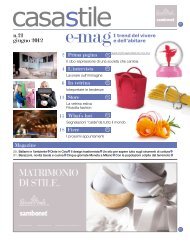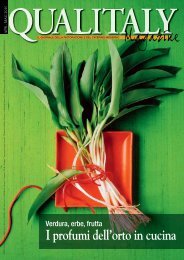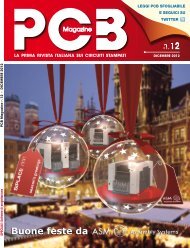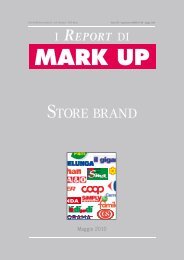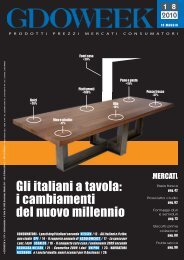Fresh Point Magazine - B2B24 - Il Sole 24 Ore
Fresh Point Magazine - B2B24 - Il Sole 24 Ore
Fresh Point Magazine - B2B24 - Il Sole 24 Ore
Create successful ePaper yourself
Turn your PDF publications into a flip-book with our unique Google optimized e-Paper software.
most evident in the upswing in acreage and yields.<br />
The leader is Germany, which has gone from a<br />
mere 8,400 ha in 1998 to a stable 13,000 ha in<br />
2009, for a crop of 152,000 tons, according to survey<br />
figures reported by AMI. Although Holland and<br />
Belgium saw their acreage in decline by the late<br />
1990s, their crop has since bounced back to about<br />
40,000 tons in each country and is expected to<br />
grow again this year.<br />
We are seeing the same trend too in the UK, where<br />
acreage is estimated to stand at 4,500 ha and the<br />
crop at 87,000 tons. Yet these positive developments<br />
of the past few years have also led to notable<br />
problems in handling the summer supply in the markets<br />
of northern Europe. This situation in turn has<br />
been driving the search for alternatives in terms of<br />
marketing calendar and, hence, the breeding of new<br />
cultivars that underpins what we have called the<br />
area’s renewed industry.<br />
In effect, the marketing calendar has been extended<br />
with greenhouse varieties that grow from mid-<br />
February to December, and the varietal assortment<br />
is being bolstered. In fact, while Elsanta still<br />
accounts for nearly 50% of acreage in Germany,<br />
more than 70% in Belgium’s markets and still dominates<br />
production in the Netherlands, it is gradually<br />
yielding ground to cultivars like Darselect and<br />
the ore recent Cléry, Sonata, Ava Elianny and<br />
Charlotte.<br />
(English version by David Verzoni)<br />
Una filiera rinnovata in Nord Europa<br />
In questi ultimi anni, i passi avanti più notevoli sono stati<br />
compiuti dalle produzioni del Nord Europa. Le superfici<br />
sono state estese molto sensibilmente in Germania (8.400<br />
ettari nel 1998) per stabilizzarsi ad oggi attorno ai 13.000<br />
ettari (pari a una produzione di 152.000 tonnellate nel<br />
2009, secondo le cifre dell’Ami). Nonostante tendessero a<br />
indebolirsi alla fine degli anni ‘90, le piantagioni di fragole<br />
hanno conosciuto un nuovo slancio nei Paesi Bassi e in<br />
Belgio (più di 40.000 tonnellate a testa) e dovrebbero ulteriormente<br />
crescere quest’anno. Al contempo anche le<br />
superfici coltivate nel Regno Unito raggiungono oggi 4.500<br />
ettari, per una produzione di 87.000 tonnellate.<br />
D’altra parte, il sensibile sviluppo del potenziale in questi<br />
ultimi anni ha generato importanti difficoltà di smaltimento<br />
in Nord Europa, specialmente in estate, spingendo<br />
alla ricerca di alternative in termini di calendario e di<br />
diversificazione delle varietà che permettano il rinnovamento<br />
di queste produzioni.<br />
<strong>Il</strong> calendario si è nettamente allungato con lo sviluppo delle<br />
produzioni sotto serra (da metà febbraio a dicembre). La<br />
gamma delle differenti tipologie si è anch’essa a sua volta<br />
estesa. Così la varietà Elsanta va progressivamente perdendo<br />
la sua posizione di egemonia sul mercato. Rappresenta<br />
ancora il 50% circa delle colture in Germania, più del 70%<br />
della produzione delle Veiling belghe e domina ancora l’offerta<br />
nei Paesi Bassi. Tuttavia altre varietà – come la Darselect o,<br />
più recentemente, Cléry, Sonata, Ava, Elianny e la stessa<br />
Charlotte – stanno guadagnando uno spazio crescente.<br />
(Traduzione dal francese di David Verzoni)<br />
<strong>Fresh</strong> <strong>Point</strong> <strong>Magazine</strong> n.4 – april/aprile 2010<br />
51<br />
product/strawberry<br />
prodotto/fragola


